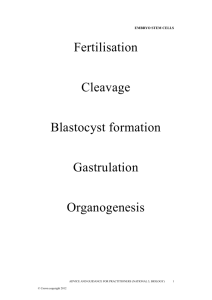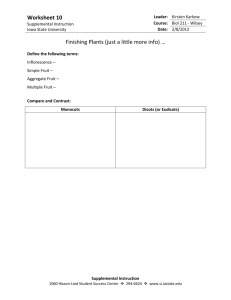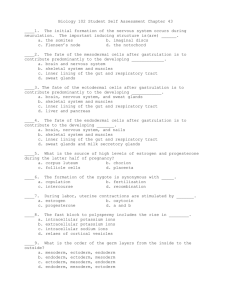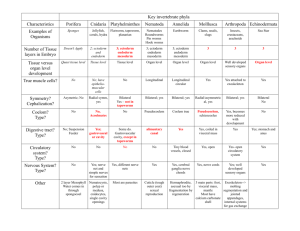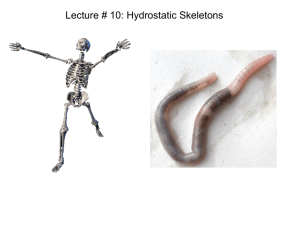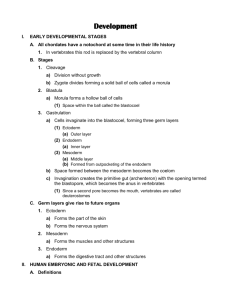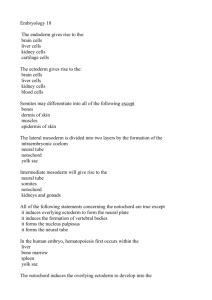Animal-diversity-2
advertisement
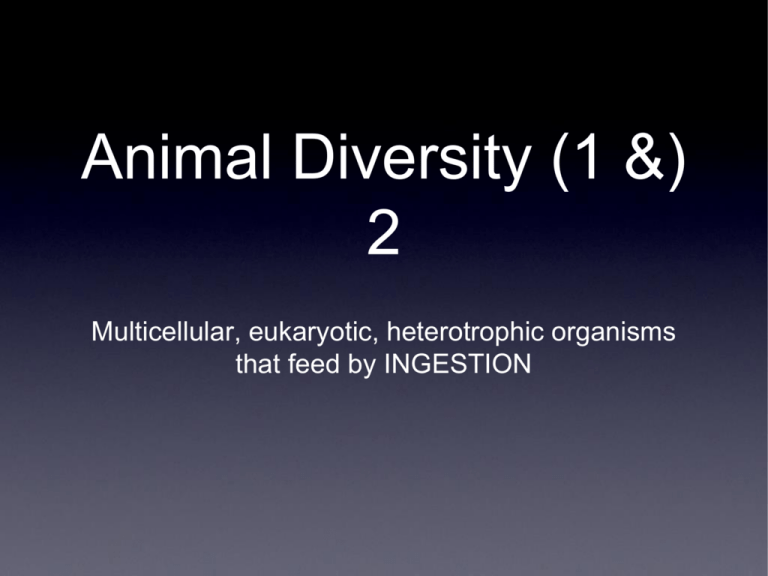
Animal Diversity (1 &) 2 Multicellular, eukaryotic, heterotrophic organisms that feed by INGESTION Body symmetry Radial symmetry Bilateral symmetry Bilateral symmetry Dorsal Anterior Posterior Ventral Tissue organization 2 tissue layers = Radially symmetric 3 tissue layers = Bilaterally symmetric Two tissue layers: Endoderm and Ectoderm Ectoderm Endoderm Gut Ectoderm Endoderm Gut Ex: Hydra Three tissue layers: Ectoderm, Mesoderm, Endoderm Ectoderm: External Layer Skin cells of epidermis Neurons of brain Mesoderm: Middle Layer Endoderm: Internal Layer Lung (Alveolar) cells Thyroid cells Pancreatic cells Cardiac muscle, Skeletal muscle,Kidney cells, Red blood cells, Smooth muscle in gut Body cavity Acoelomate Pseudocoelomate Eucoelomate Other characteristics: • • • • • • Openings into digestive tract: One opening or tube within a tube? Open vs. closed circulatory system Organs for gas exchange Organs for excretion Endoskeleton, exoskeleton, hydrostatic skeleton? Segmentation Porifera (i.e. sponges) Cnidaria (e.g. Hydra, sea anemones, jellyfish) 2 tissue layers Platyhelminthes (Flatworms) 3 tissue layers Acoelomate unsegmented No internal organs = must be flat to allow O2 and nutrients in via diffusion Most are parasitic – Schistosomiasis is a disease caused by these guys. Tapeworm too. Annelida (Clamworms and earthworms) Segmentation! Organs! They’re hydrostatic! Annelida (Clamworms and earthworms) Mollusca More than 85,000 species! Characteristics of most molluscs: • • • • Hard external shell for protection Mantle (excretes shell) Visceral mass Muscular foot for locomotion Snail radula! Ex: cuttlefish Basic bivalve anatomy Adductor muscles are welldeveloped in scallops because they’re active swimmers. (They’re also tasty) Onwards! …to Ecdysozoa = molting animals (Nematoda and Arthropoda) Body covering = cuticle = exoskeleton Nematoda • • • • • • Most abundant animal on Earth Pseudocoelomate Up to a million different species (only like 50k described) 15,000 species are described as parasitic Sheds proteinaceous cuticle LOTS of investment in reproductive organs Arthropoda • • • • • Animals with exoskeleton, segmented body, and jointed appendages Exoskeleton is periodically shed Four subphyla: Cheliceriformes, Myriapoda, Crustacea, Hexapoda Exoskeleton is mainly chitin First organisms to fly – unoccupied niche (air) allowed for massive radiation Cheliceriformes • • No antennae, no jaws Pincer-like appendages called chelicera used for grasping and fragmenting food Myriapoda Millipedes 2 pairs of legs per segment Detritivores Centipedes 1 pair of legs per segment Predators Crustacea • • • • Biramous (two-parted) limbs (even barnacles) Most are free-living aquatic animals Some (e.g. pill bugs) are terrestrial Some (e.g. barnacles) are sessile Ex: Crustacean claws branch into 2 segments Hexapoda: Six-legged arthropods External insect anatomy 3 distinct body units: head, thorax, and abdomen Insect head: Search for: compound eyes, ocelli, antennae, labrum, mouthparts Insect mouthparts: Mandible, maxilla, labium Evolution of mouthpart morphology Chewing mouthparts (e.g. grasshopper) A: Chewing B: Lapping (e.g. bee) C: Siphoning (e.g. moth) D: Sucking (e.g. mosquito) Arthropod respiration: Tracheal system Final notes: No labs next week. Then only two more labs: - Animal Diversity 3 (chordates and starfish) - and then a final lab practical (no lecture for the last lab) I will post a study guide this week on thinkbiologically.com Don’t forget to turn in your reports! Lots to do today! Have fun!
